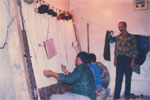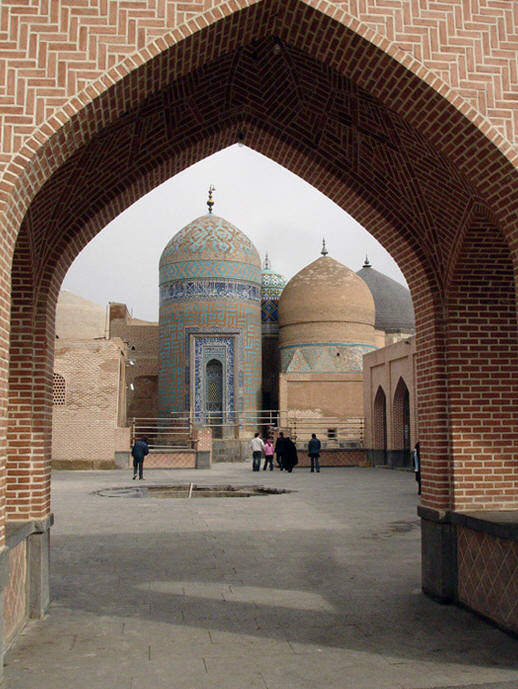 |
 |
 |
| City &
Highlight Sightseeing ::
Ardebil ::
Highlights |
 |
 |
 |
 |
|
|
 |
|
 |
|
 |
 |
|
ARDEBIL SPECIALS: |
 |
 |
|
ALL HOTELS &
GUESTHOUSES: |
|
   |
|
Ardabil
was probably founded in the 5th century AD. It
became (10th century) the capital of Azarbaijan, but
was soon superseded by Tabriz. In 1220 AD it was
destroyed by the Mongols. Ardabil is best known as
the birthplace of the eminent religious leader Sheik
Safi od-Din (1251-1334) from whom the Safavid
dynasty was descended. Sheikh Safi was the founder
of a sufi order and monastery in Ardabil, the prime
mover of Iranian culture during the 15-16th century
and the center of the theocratic community of
Dervish Brotherhood. Dervishes, after coming
together under the same organizational structure,
managed to attract and retain the attention of large
masses in the towns and in the country. Ismail, a
descendent of Sheikh Safi and who was later crowned
as the Shah of Persia in Tabriz (1501), was himself
a member of this order. The main objectives of
Dervish Brotherhood were the elimination of the then
rampant anarchy and the reorganization of a new
state that could respond to the demands of the urban
and the rural disinherited of Iran and satisfy the
peoples thirst for justice. Shiism began to spread
through mosques, monasteries and Dervish centers,
and very soon conquered the masses. Shah Ismail
created an immense empire: he succeeded in
subjecting the many principalities that had formed
after the fall of Timurid state. In 1510 he defeated
the Khan and conquered Baghdad. The decision to
uphold Shiism might be interpreted as an extreme
endeavor to prevent the Iranian nation from becoming
absorbed by the west (Ottomans) and the east
(Uzbeks). The town was occupied by the Turks in 1725
and the Russians in 1828. Its proficient library was
taken to St. Petersburg by the Russians.
Annual
Temperature average:
 |
 |
 |
| |
 |
|
Mausoleum of Sheikh
Safi
Sheik Safis 14th
century tomb in Ali Qwapu Square, often
enlarged and restored in later
centuries, can still be visited. It
houses the mortal remains of Shah Ismail
as well as his saintly ancestor, who is
reputed to have foretold the future,
spoken to the dead and rescued those in
danger at sea. The tombs are surrounded
by finely engraved wood panels with
extraordinarily delicate ivory and
precious metal inlays.
The complex of
structures known, at present, as Sheikh
Safis Mausoleum, consists of a portal,
a porch, Sheikh Safis tomb-chamber, the
Chini Khaneh (china hall), the Shahidgah
(martyrdom site), the Khaneghah (dervish
monastery), Qandil Khaneh (lantern
hall), the Jannat Sara Mosque, and
others, and ranks among the finest
historical achievement of Iranian art.
The burial place of
Sheikh Safi od-Din Ardabili as well as
other Safavid kings, such as Shah
Ismail, comprises the tombs of a number
of princes, notables and generals of the
Safavid period, including the tomb
attributed to Shah Ismails mother, and
those of Sheikh Sadr of-Din, Sheikh
Junaid, Sultan Heidar and two generals,
namely Sultan Ustajilu and Kurd Beig,
the latters tombstone bearing the 1542
AD date.
Apart from the above
structures, the construction of the main
portal of the mausoleum and three domes
decorated with exquisite faience tile
and inscriptions in the Kuffic and Riqa
scripts, give considerable charm and
splendor to this attractive historical
monument. The decorative elements of the
complex, both internal and external,
consist of paintings, plaster moldings,
stuccos and gold-toned stalactite
decorations.
The structure of the
Qandil Khaneh stands out among the rest
both from the architectural as well as
the plaster points of view. Sheikh
Safis tomb-chamber is a cylindrical
tower capped with a rather low dome,
underneath which an exquisite carved box
bearing an inscription in Riqa script
covers the actual burial ground. The box
is one of the finest movable treasure
pieces of the mausoleum.
The dome of Sheikh
Ismails tomb-chamber is lower than that
of Sheikh Safi, and is decorated on the
outside with colorful tiles and an
inscription in Kuffic. Under the dome in
the chamber a fine, costly box rests
upon the tomb.
The box on Sheikh
Junaids tomb, together with three other
boxes in the complex, are highly
attractive on account of their superb
carvings.
There
is a large vaulted hall next to the
mausoleum wherein Shah Abbas the Great
stored the collection of jade and
porcelain given to him by the Emperor of
China. Each object was placed in a
gold-plated niche cut to size. The gold
has worn off and most of the objects
(except about a dozen dishes and
receptacles) are now in Tehran museums.
The
oldest part of the complex belongs to
the 15th century AD, the other parts
having been gradually added,
particularly under Shah Tahmasp I and
Shah Abbas II, who spared no efforts to
expand, beautify and repair the Safavid
Kings eternal resting place.
The
most famous of Persian carpets, the
so-called "Ardabil Carpet" (one of a
pair) in the Victorian and Albert
Museum, was presented to the mausoleum
by Shah Tahmasp in 1539. It was actually
made in Kashan.
|
|
|
|
 |
 |
 |
 |
 |
 |
| |

|
|
Historic Bridges
Most of the existing
bridges date back to the Safavid period:
Jejin
(Yeddi Guz), on Balikhlu river, with
stone abutments and brick arches,
already used by the public.
Ebrahim Abad, located between the
Varzesh Square and Ali Abad.
Yaghubieh, with five spans, located in
Pasdaran Street.
Seyed Abad, located at the beginning of
Seyed Abad Alley and Pir Madar district.
Kalkhoran, in Kalkhoran village.
Nir, on Aghla Ghan river.
Ghara Su, on Balikhlu river.
Almas, on Balikhlu river, km 13 of
Ardabil-Sarab road, in the vicinity of
Almas village.
EXCURSIONS AROUND ARDABIL
|
|
|
|
 |
 |
 |
 |
 |
 |
| |
|
|
|
Mount Sabalan
Sabalan is Irans
second highest mountain peak 25 km to
the west of Ardabil. It is higher than
Mont Blanc the Alpin massif on the
French-Italian border, with many lakes
and a volcanic crater, soaring high up
to almost 4, 860 meters above sea level.
At the height of 3, 600 meters above sea
level and further high, and all around
the Sabalan crater, a number of gigantic
sculpture (animals, birds, insects, etc)
have emerged as the result of rock
erosion. The most beautiful creature
among these is an eagle statue seeming
to maintain control over the Sabalan
slope and valley from atop. The mount
represents a myriad of attractions in
various seasons of the year, to the
extent that upon reaching the peak, one
feels having arrived in a land of
dreams. Many hot mineral spas and cold
water springs originate from its slopes
and attract millions of tourists to the
region every year. The hot water is said
to have effective healing properties.
The mount, the extinct crater, and the
lake can be ascended usually from the
northern and southern tracks. When on
top, you can see a panorama of the
beautiful region for more than a hundred
kilometers all around you. The lake
occupies an area of 50 by 50 meters, and
is 15 meters deep. Since it is covered
with ice from mid-September through
early June the next year, mountain
climbers use it for skating.
|
|
|
|
 |
 |
 |
 |
 |
 |
| |
|
|
|
Kalkhoran The 16-century AD mausoleum of
Sheikh Safis father, Sheikh Jabrail, is
in the village of Kalkhoran, 3 km to the
north of Ardabil. It is a four-sided
structure with an ivan, two porches and
a tiled dome, and is of particular
importance in respect of its plaster
stalactite decorations, plentiful
ornamental elements, exceptional tile
work, carvings, and excellent
inscriptions. Repaired in 1621 AD during
the reign of Shah Abbas I, the mausoleum
comprises many other historical tombs
all around the courtyard, including
those of Seyed Hamza, Seyed Mohammad
Iraqi, and Firuz Shah, most of whom were
among the commanders and dignitaries of
the Safavid period. Sare Ein This is a
really tourist town 29 km to the west of
Ardabil. It is one of the most important
hot spring spa centers in Iran and the
world, annually attracting more than
1,500,000 visitors coming to use its 9
spas with therapeutic values. A
hydrotherapical center under
construction here will be completed soon
and can be used both by Iranians and
foreigners.
|
|
|
|
 |
 |
 |
|
 |
|
 |
|
|
|
| Suggest your comments about nearby Sightseeing |
Private and group tours Tours , also Accommodation reservation services are available at www.PersiaTours.com for further information , please contact us.
Use the following keywords to find this page online:
Ardebil , Travel Ardebil , Ardebil
vacations, Ardebil tourism, Ardebil
hotels, deals, Ardebil historical travel tour,
Ardebil visitors guide, Ardebil advice,
Ardebil map, Ardebil pictures, Ardebil
information, Ardebil ratings, Ardebil
reviews, Ardebil airport, Ardebil
weather, Ardebil things to do, Ardebil
attractions, Ardebil cultural tours iran ,
Ardebil travel to Iran, Ardebil Iran
tours, Ardebil Iran touring, Ardebil
Iran tourism, Tour to Ardebil , Tours in Ardebil ,
Ardebil tour operator, Adventure tours in
Ardebil , Business Travel to Ardebil , Business Trip
to Iran, Archaeology tour in Ardebil , Pilgrim tours
in Ardebil , Persian tours Ardebil , cultural tours
in Ardebil , geographical tours in Ardebil ,
Persia, tour to Persia, Trekking tours in Ardebil ,
hunting tours in Iran , historical tours in Iran ,
climbing tours in Iran Ardebil |
|
|
|
|
 |
 |
 |




